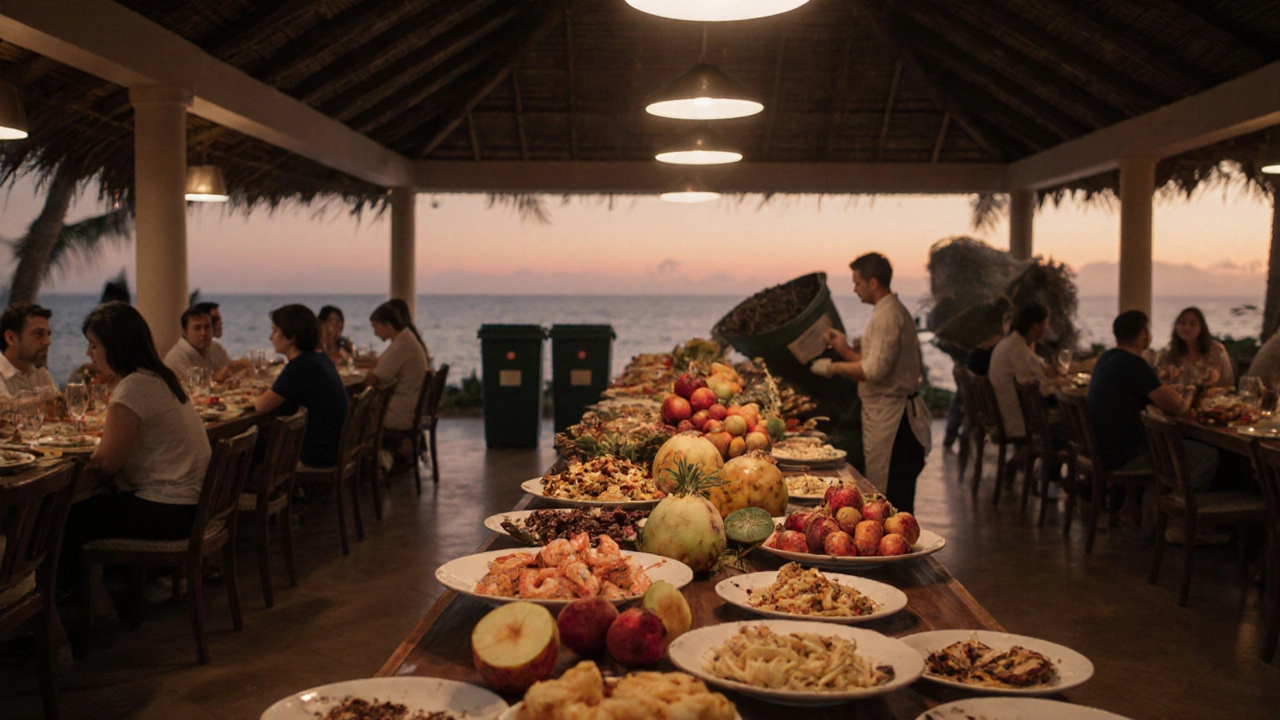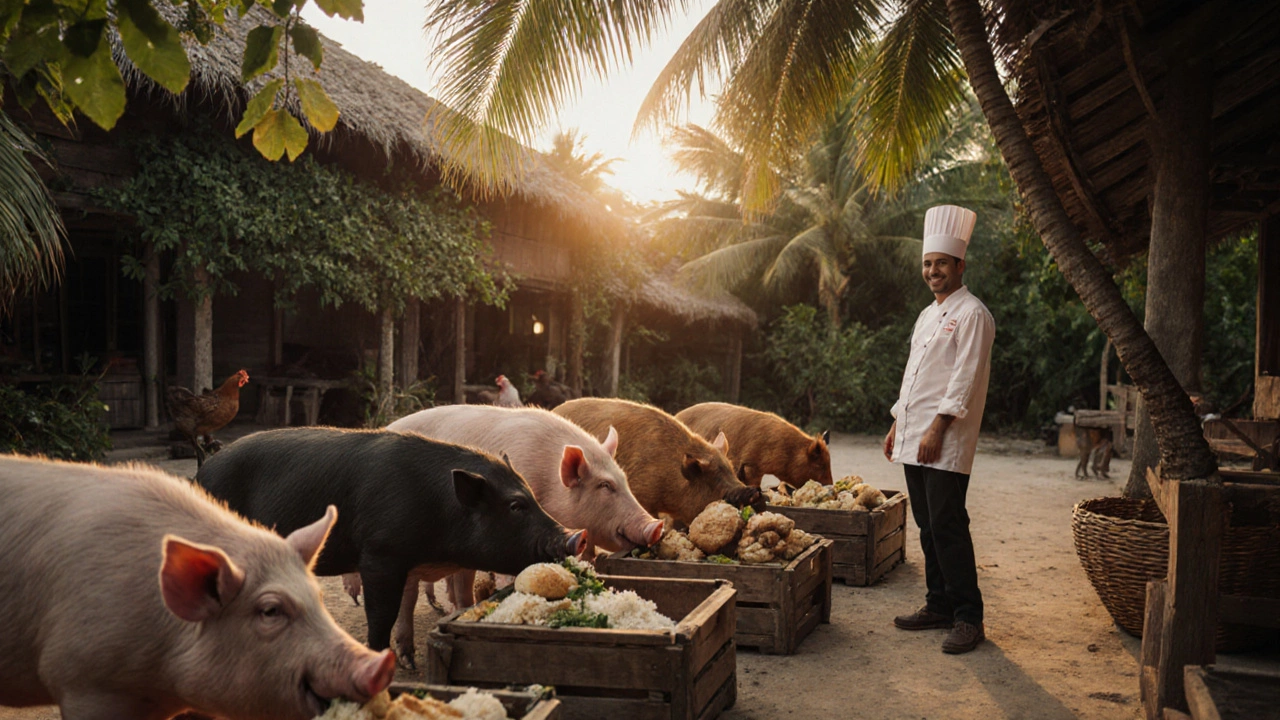What Happens to Leftover Food in All-Inclusive Hotels?
 Nov, 24 2025
Nov, 24 2025
All-Inclusive Hotel Food Waste Calculator
Calculate Your Hotel's Food Waste
Based on 2.3 kg (5 lbs) of food waste per guest per stay as reported by the Sustainable Hospitality Alliance
Estimated Food Waste
That's equivalent to:
- %s lbs of produce wasted per day
- %s meals donated to local communities
- %s kg of CO2 emissions prevented through composting
Ever stood in line at an all-inclusive resort buffet, plate piled high with grilled shrimp, pasta, tropical fruit, and dessert, only to walk away with half of it untouched? You’re not alone. Millions of guests do it every year. But what happens to that mountain of untouched food when the buffet clears? It doesn’t just vanish. And it’s not all thrown in the trash.
How Much Food Is Actually Wasted?
All-inclusive resorts serve food nonstop-breakfast, lunch, dinner, snacks, midnight bites. The goal? Make guests feel like they’re getting their money’s worth. But that mindset leads to overproduction. A 2023 study by the Sustainable Hospitality Alliance found that all-inclusive hotels waste an average of 2.3 kilograms of food per guest per stay. Multiply that by 500 guests on a busy day, and you’re looking at over a ton of food wasted daily at a single mid-sized resort.
It’s not just about quantity. It’s about quality. Fresh seafood, ripe mangoes, handmade pastries, and artisanal cheeses often sit out for hours under heat lamps, then get tossed because they’re no longer "perfect"-even if they’re still perfectly edible.
The Buffet System Is the Problem
The all-inclusive buffet isn’t designed for efficiency. It’s designed for perception. More food on display = guests feel richer. More variety = guests feel pampered. But this creates a cycle: chefs prepare for the worst-case crowd, not the actual one. If 300 people showed up last night, they’ll cook for 400 tonight. And if the weather’s bad and only 200 show up? That extra 200 portions? Gone.
Some resorts try to cut waste by offering smaller portions or fewer options, but guests complain. "Where’s the lobster?" "Why is there only one kind of salad?" So they go back to the pile-high buffet. It’s a trap.
What Resorts Actually Do With Leftovers
Not all leftover food ends up in the landfill. Many resorts have systems in place, though they vary wildly by location and budget.
- Composting: In places like Costa Rica, Mexico, and parts of the Caribbean, resorts partner with local farms to turn organic waste into fertilizer. Banana peels, vegetable scraps, coffee grounds-they all go into compost bins. Some even sell the compost back to local growers.
- Animal Feed: In rural areas, leftover bread, rice, and cooked vegetables often go to pigs, chickens, or even goats kept on resort property. One resort in the Dominican Republic feeds its 14 pigs daily with surplus food. They’ve cut their feed bill by 60%.
- Donations: A growing number of resorts in the U.S., Canada, and Europe now partner with food banks or shelters. In Florida, the Hilton All-Inclusive chain donates over 8,000 meals a month to local organizations. The food is packed, labeled, and transported within hours of service.
- Recycling into New Dishes: Some chefs get creative. Leftover rice becomes fried rice the next day. Stale bread turns into bread pudding. Overripe fruit gets blended into smoothies or jams served at breakfast. One resort in Bali trains staff to repurpose 40% of daily leftovers into new menu items.
- Incineration or Landfill: Still the most common fate-especially in regions with no composting infrastructure or strict health codes. Food waste is mixed with other trash, burned, or buried. This releases methane, a greenhouse gas 25 times more potent than CO2.

Why Don’t All Resorts Do More?
It’s not laziness. It’s logistics.
Food donation requires permits, cold storage, transportation, and staff time. Many resorts operate in remote areas with no nearby charities. Composting needs space, equipment, and training. Staff are already stretched thin. And management often sees food waste as a cost of doing business-something absorbed into the "all-inclusive" price tag.
There’s also a fear: if guests see less food on the buffet, they’ll think they’re getting less value. Even if it’s the same amount, just better portioned. Perception still beats reality in hospitality.
What’s Changing?
Guests are starting to ask questions. Social media posts like "Why is my resort throwing away 100 lobsters?" go viral. Travelers now check hotel sustainability reports before booking. In 2024, 68% of travelers said they’d pay more to stay at a resort with a clear food waste policy, according to Booking.com’s sustainable travel report.
Resorts are responding. Hyatt’s all-inclusive properties now use AI-powered forecasting tools that analyze weather, bookings, and historical data to predict exact food needs. Some use smart bins that weigh and track what’s thrown out-giving chefs real-time feedback. Others have switched to made-to-order stations instead of giant buffets for dinner.
One resort in Jamaica cut its food waste by 52% in 18 months by replacing buffets with a reservation-based dining system. Guests pick their meal the night before. No more guessing. No more piles of untouched food.
What You Can Do as a Guest
You don’t have to be perfect. But small changes add up.
- Take less. You can always go back. Seriously. The food’s still there.
- Use the smaller plates if they’re offered. They’re not just for kids.
- Ask if leftovers are donated or composted. If they are, thank them. If they don’t, ask why. Your question might spark change.
- Don’t take that extra dessert just because it’s there. You’ll regret it later anyway.
- Choose resorts that advertise sustainability. Look for terms like "zero-waste dining" or "local food sourcing." They’re not just marketing-they’re practices.
When you take less, you’re not being cheap. You’re being respectful-to the staff who cooked it, to the planet that grew it, and to the people who don’t have enough.
The Bigger Picture
Food waste in tourism isn’t just a hotel problem. It’s a global one. The UN estimates that 8-10% of global greenhouse gas emissions come from wasted food. Resorts are a small part of that-but they’re a visible one. And when a luxury resort throws away a whole roasted pig because no one ate it, it sends a message: food is endless.
It’s not.
The truth is, the all-inclusive model doesn’t have to mean waste. It can mean abundance without excess. It can mean generosity that doesn’t cost the earth. The technology, the partnerships, and the awareness are already here. What’s missing is the will to change.
Next time you’re at a buffet, ask yourself: Am I here to eat-or to prove I can eat everything?
Do all-inclusive hotels throw away all their leftover food?
No, not all of it. Many resorts now compost organic waste, donate edible food to local charities, or repurpose leftovers into new dishes. Some even use it for animal feed. But in places without infrastructure or strict health rules, food still ends up in landfills or incinerators.
How much food do all-inclusive hotels waste per guest?
On average, each guest generates about 2.3 kilograms (5 pounds) of food waste during a typical stay. That adds up to over a ton of waste per day at a medium-sized resort with 500 guests.
Can I help reduce food waste at my resort?
Yes. Take smaller portions, go back for seconds if you’re still hungry, avoid taking food you won’t eat, and ask staff if they donate or compost leftovers. Your choices influence their practices-and your feedback matters.
Are there all-inclusive resorts that don’t waste food?
Yes. Resorts in Costa Rica, Jamaica, and parts of Europe have cut waste by over 50% using made-to-order dining, AI food forecasting, and strict portion controls. They still offer variety-but without the wasteful buffet piles.
Why don’t more resorts donate food to local communities?
Logistics. Many resorts are in remote areas with no nearby charities, refrigerated transport, or legal protections for food donors. In some countries, liability laws make donation risky. But where it’s possible, more resorts are starting to do it-especially with pressure from guests and global sustainability standards.